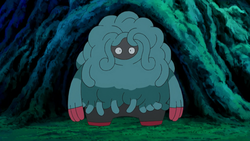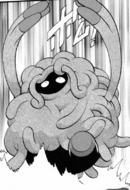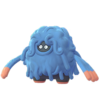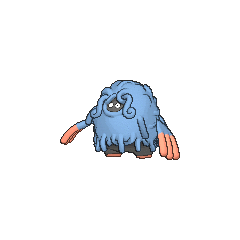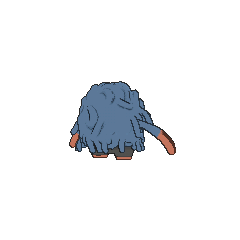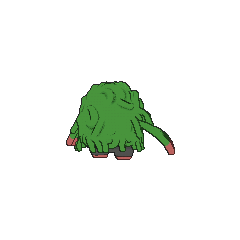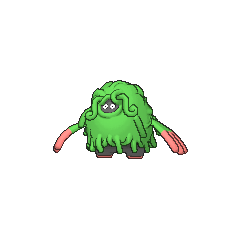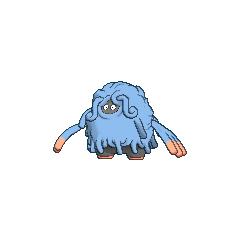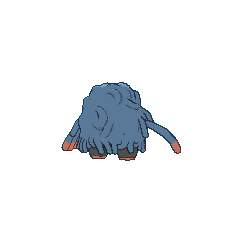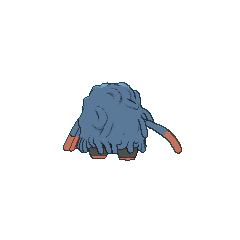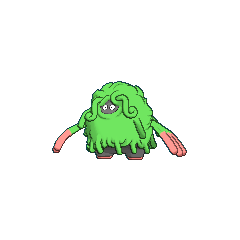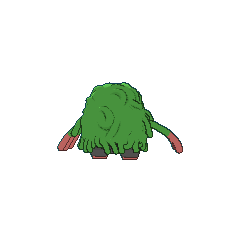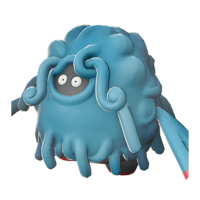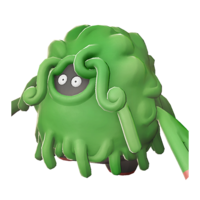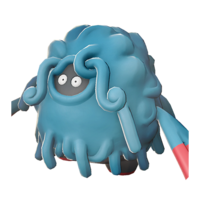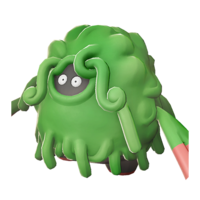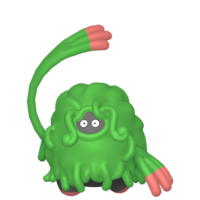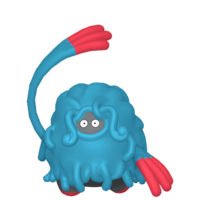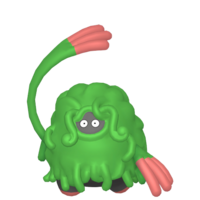Biology
Tangrowth is a large Pokémon with a black body wrapped in a large mass of blue vines. The vines are used to entangle foes and prey. A pair of saucer-like eyes peek out from beneath the tangled mess of vines. Its stubby black feet are tipped with red. Tangrowth has a pair of blue boneless arms that have three fingers. The arms are made from bundles of vines. These fingers are completely red on a female Tangrowth, while they have red tips on a male.
Tangrowth is unfazed if one of its arms is broken off, as it will easily grow back. It hunts by disguising itself as a shrub, then grabbing prey with its vines. However, Tangrowth has been known to eat fruit as well. It can extend its arms as much as it wants. Predators like to eat Tangrowth's vines. When the climate is warm, its vine growth is accelerated to the point where not even its eyes can be seen. If its vines grow too long, Tangrowth shortens them by tearing bits of them off. Tangrowth is very rare in the wild, though it can be found in temperate grasslands.
Evolution
Tangrowth evolves from Tangela.
(For specifics on this Pokémon's Evolution in the games, refer to Game data→Evolution data.)
Game data
Pokédex entries
| This Pokémon was unavailable prior to Generation IV.
|
| Generation IV
|
|
Sinnoh
Pt : #182
|
|
Johto
#183
|
| Diamond
|
It ensnares prey by extending arms made of vines. Losing arms to predators does not trouble it.
|
| Pearl
|
| Platinum
|
Its arms are made of plants that bind themselves to things. They grow back right away if cut.
|
| HeartGold
|
When it remains still, it appears to be a large shrub. Unsuspecting prey that wander near get ensnared by its vines.
|
| SoulSilver
|
Its vines grow so profusely that, in the warm season, you can't even see its eyes.
|
|
|
| Generation V
|
|
|
Unova
B2 W2 : #218
|
| Black
|
Its arms are made of plants that bind themselves to things. They grow back right away if cut.
|
| White
|
| Black 2
|
Even if one of its arms is eaten, it's fine. The Pokémon regenerates quickly and will go right back to normal.
|
| White 2
|
|
|
| Generation VI
|
|
Kalos
#—
|
|
Hoenn
#—
|
| X
|
It ensnares prey by extending arms made of vines. Losing arms to predators does not trouble it.
|
| Y
|
Its vines grow so profusely that, in the warm season, you can't even see its eyes.
|
| Omega Ruby
|
It ensnares prey by extending arms made of vines. Losing arms to predators does not trouble it.
|
| Alpha Sapphire
|
Its vines grow so profusely that, in the warm season, you can't even see its eyes.
|
|
|
|
|
| Generation VIII
|
|
Galar
Isle of Armor #081
|
|
Sinnoh
#—
|
|
Hisui
#096
|
| Sword
|
Tangrowth has two arms that it can extend as it pleases. Recent research has shown that these arms are, in fact, bundles of vines.
|
| Shield
|
Vine growth is accelerated for Tangrowth living in warm climates. If the vines grow long, Tangrowth shortens them by tearing parts of them off.
|
| Brilliant Diamond
|
It ensnares prey by extending arms made of vines. Losing arms to predators does not trouble it.
|
| Shining Pearl
|
| Legends: Arceus
|
Draped with long vines, it resembles a shrub in appearance. It swings bundles of vines as though they were arms, wrapping them around prey to ensnare them.
|
|
|
|
|
Game locations
| This Pokémon was unavailable prior to Generation IV.
|
|
|
|
|
|
|
|
|
|
|
|
|
In side games
| This Pokémon was unavailable prior to Generation IV.
|
|
|
|
|
|
|
|
|
|
|
|
|
In events
Held items
Stats
Base stats
| Stat
|
Range
|
| At Lv. 50
|
At Lv. 100
|
100
|
|
160 - 207
|
310 - 404
|
100
|
|
94 - 167
|
184 - 328
|
125
|
|
117 - 194
|
229 - 383
|
110
|
|
103 - 178
|
202 - 350
|
50
|
|
49 - 112
|
94 - 218
|
50
|
|
49 - 112
|
94 - 218
|
Total: 535
|
Other Pokémon with this total
|
- Minimum stats are calculated with 0 EVs, IVs of 0, and (if applicable) a hindering nature.
- Maximum stats are calculated with 252 EVs, IVs of 31, and (if applicable) a helpful nature.
|
Pokéathlon stats
Type effectiveness
| Under normal battle conditions in Generation IX, this Pokémon is:
|
|
|
|
|
|
|
|
|
|
|
|
|
Learnset
Tangrowth is available in Sword and Shield Version 1.2.0+, Brilliant Diamond and Shining Pearl, and Pokémon Legends: Arceus.
SwShBDSP
|
|
|
|
- Bold indicates a move that gets STAB when used by Tangrowth
- Italic indicates a move that gets STAB only when used by an Evolution of Tangrowth
- Click on the generation numbers at the top to see level-up moves from other generations
|
LA
|
|
|
|
- Bold indicates a move that gets STAB when used by Tangrowth
- Italic indicates a move that gets STAB only when used by an Evolution of Tangrowth
- Click on the generation numbers at the top to see level-up moves from other generations
|
SwSh
|
|
|
|
- Bold indicates a move that gets STAB when used by Tangrowth
- Italic indicates a move that gets STAB only when used by an Evolution of Tangrowth
- Click on the generation numbers at the top to see TM moves from other generations
|
BDSP
|
|
|
|
- Bold indicates a move that gets STAB when used by Tangrowth
- Italic indicates a move that gets STAB only when used by an Evolution of Tangrowth
- Click on the generation numbers at the top to see TM moves from other generations
|
SwSh
|
|
|
|
- Moves marked with an asterisk (*) must be chain bred onto Tangrowth in Generation VIII
- Moves marked with a double dagger (‡) can only be bred from a Pokémon who learned the move in an earlier generation.
- Moves marked with a superscript game abbreviation can only be bred onto Tangrowth in that game.
- Bold indicates a move that gets STAB when used by Tangrowth
- Italic indicates a move that gets STAB only when used by an Evolution of Tangrowth
- Click on the generation numbers at the top to see Egg moves from other generations
|
BDSP
|
|
|
|
- Moves marked with an asterisk (*) must be chain bred onto Tangrowth in Generation VIII
- Moves marked with a double dagger (‡) can only be bred from a Pokémon who learned the move in an earlier generation.
- Moves marked with a superscript game abbreviation can only be bred onto Tangrowth in that game.
- Bold indicates a move that gets STAB when used by Tangrowth
- Italic indicates a move that gets STAB only when used by an Evolution of Tangrowth
- Click on the generation numbers at the top to see Egg moves from other generations
|
SwShBDSP
|
|
|
|
- Bold indicates a move that gets STAB when used by Tangrowth
- Italic indicates a move that gets STAB only when used by an Evolution of Tangrowth
- Click on the generation numbers at the top to see Move Tutor moves from other generations
|
LA
|
|
|
|
- Bold indicates a move that gets STAB when used by Tangrowth
- Italic indicates a move that gets STAB only when used by an Evolution of Tangrowth
- Click on the generation numbers at the top to see Move Tutor moves from other generations
|
|
|
|
|
- Bold indicates a move that gets STAB when used by Tangrowth
- Italic indicates a move that gets STAB only when used by an Evolution of Tangrowth
- Click on the generation numbers at the top to see moves from other generations
|
By transfer from another generation
|
|
|
|
- Transferred Pokémon only retain these moves in Pokémon Sword and Shield
- A striped background indicates a generation in which the move can only be obtained via event or as a special move
- Bold indicates a move that gets STAB when used by Tangrowth
- Italic indicates a move that gets STAB only when used by an Evolution of Tangrowth
- × indicates a move that cannot be used in Sword and Shield
- Click on the generation numbers at the top to see transfer-only moves for other generations
|
|
|
|
|
- Transferred Pokémon only retain these moves in Pokémon Sword and Shield
- A striped background indicates a generation in which the move can only be obtained via event or as a special move
- Bold indicates a move that gets STAB when used by Tangrowth
- Italic indicates a move that gets STAB only when used by an Evolution of Tangrowth
- × indicates a move that cannot be used in Sword and Shield
- Click on the generation numbers at the top to see transfer-only moves for other generations
|
Side game data
|
|
|
|
|
|
Pokémon Ranger: Guardian Signs
| Group:
|
|
Poké Assist:
(present)
|

|
Field move:
(present)
|

(Crush ×3)
|
Poké Assist:
(past)
|

|
Field move:
(past)
|

(Crush ×1)
|
| Browser entry R-289/N-053
|
| It creates vines around itself that make Pokémon Slowed.
|
|
|
|
|
|
Pokémon Rumble Rush

|
Walking Speed: 1.42 seconds
|
Base HP: 59
|
|
| Base Attack: 81
|
Base Defense: 57
|
Base Speed: 60
|
|
|
|
|
|
|
|
|
|
New Pokémon Snap

|
| Photodex entry #007
|
| Tangrowth uses its vine arms to nimbly pluck fruit that’s just out of reach. It can also extend its arms even farther to carry itself across long distances.
|
|
|
Evolution data
Tangrowth evolves from Tangela when leveled up while knowing Ancient Power. Tangela cannot evolve into Tangrowth in Pokémon: Let's Go, Pikachu! and Let's Go, Eevee!, as Tangrowth is not present in those games.
Sprites
| This Pokémon was unavailable prior to Generation IV.
|
|
|
|
|
|
|
|
|
|
|
| This Pokémon is unavailable in Generation IX.
|
|
|
In animationIn the manga
Phantom Thief Pokémon 7
Hiori has a Tangrowth, which debuted in Challenge From A Rival. Its vines can be used as ropes to lower Hiori and others down from roofs. It can also use Sleep Powder to help Hiori get by guards.
Pokémon Adventures
In Getting Past Gastrodon, Jupiter attacked Platinum, Candice, and Maylene using her Tangrowth, Sableye, and Gastrodon when they arrived in Lake Acuity. Most notably, it faced off against Candice's Abomasnow, and was able to overpower and defeat it using a Fire-typed Natural Gift. In subsequent appearances, Jupiter's Tangrowth used only Natural Gift, and its strategy was easily worked around.
A Tangrowth liberated by Team Plasma appeared in The Final Battle: Crushed Ambition as one of the Pokémon stuck in N's Castle.
Pokémon Diamond and Pearl Adventure!
A Tangrowth appeared in A Novel Test!!, under the ownership of Jupiter.
In the TCGTrivia
Origin
Due to the mystery around Tangela's appearance under the vines, Tangrowth may be based on the swamp monster from the short story "It!" by Theodore Sturgeon, which is ultimately revealed to have formed around a human skeleton. It may also be based on a Green Man, a motif that is represented as a face surrounded by leaves and vines (this may also have inspired Tangrowth's Shiny variant's green color).
Its Pokédex entries state that its vines will bind and ensnare its surroundings. This may be a reference to thigmotropism, a biological reaction plants have towards contact that encourages them to coil around objects they touch as they grow, allowing stability in their stems and branches.
Name origin
Tangrowth may be a combination of tangle and growth.
Mojumbo may be a combination of もじゃもじゃ mojamoja (shaggy or unkempt) and jumbo.
In other languagesExternal links

|
This Pokémon article is part of Project Pokédex, a Bulbapedia project that aims to write comprehensive articles on each Pokémon species, as well as Pokémon groups and forms.
|
 For other sprites and images, please see Tangrowth images on the Bulbagarden Archives.
For other sprites and images, please see Tangrowth images on the Bulbagarden Archives.